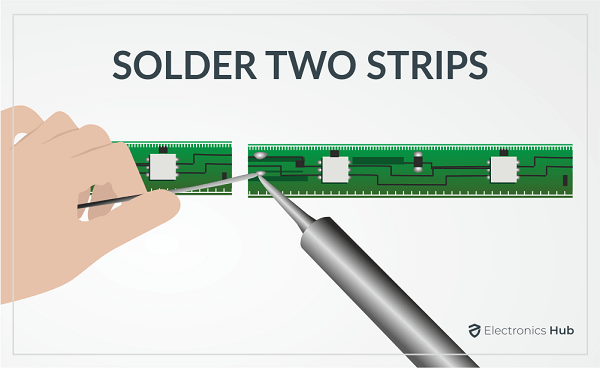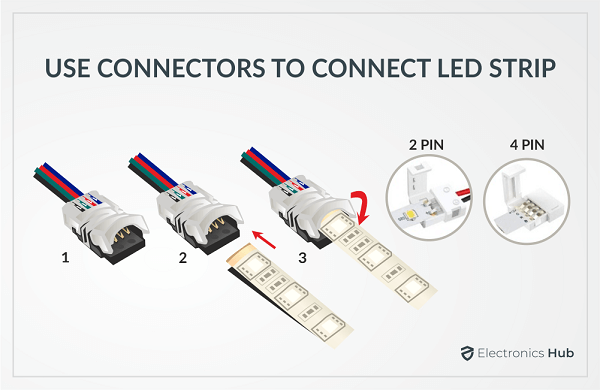LED Strip Lights are one of the best things happened in the lighting world. You can use them to decorate your art, home, light up kitchen countertop, add as a staircase lighting or roof lighting for festive season. Since they come in long strips, you can cut them into desired lengths and also connect them together to increase the length. We already saw the answer to “Can You Cut LED Strip Lights?” in an earlier guide. In this guide, we will see how to connect LED Lights together.
Outline
ToggleIntroduction
One of the main reasons for the popularity of LED Strip Lights is that you can easily set the length of strip you want. You can easily cut the LED Strip to perfectly fit the kitchen countertop or you can connect another strip to this one to cover your entire roof for holiday season.
LED Strips are available as single-color options (White, Red, Blue, etc.) where all the LEDs in the strip are of same color. They are also available as fancy RGB, where you can use a small remote control to set the color of your liking, adjust the brightness and also set different modes such as fading, flashing or running LEDs.
Some LED Strips come with weather proof coating (some sort of silicon layer on top of the actual LED strip to make it waterproof). You can use these strips outdoors with any concern about the weather. There are LED Strips that are meant only for indoor use.
The most popular length for LED Strips is 5m (slightly over 16feet). But you can also get smaller LED Strips (as in Car LED Strips) or bigger spool of LEDs that are over 50feet long.
Can You Connect Multiple LED Strip Lights Together?
The answer is yes. But there are some things you need to take care of. We will see about them as we progress.
If you already cut the LED Strip before and you want to re-connect them back to the same strip, then you don’t have to worry about anything else. All you have to do follow any one of the methods we mentioned below and continue using the extended LED Strip Lights.
Obviously, you cannot connect two dissimilar LED Strips i.e., if one is a single-color LED Strip and the other is an RGB LED Strip. In this case, the LED Strips are completely incompatible with each other and you cannot connect them together.
Another scenario is, if you have strips of two different brands, what to do then? If they are compatible with each other i.e., both of them have same layout and also both are rated for same voltage, them you can connect two LED Strips from different brands.
Voltage is another important thing to consider before connecting LED lights together. Because some strips operate at 5V DC while some strips operate at the more popular 12V DC. There are strips that operate at higher voltage such as 24V but 12V strips are extremely popular.
How to Connect LED Lights Together?
After making sure that both the LED Strips you want to connect are compatible with each other and operate at the same voltage, you are now ready to connect them. But the question is: How to Connect LED Lights Together?
There are a couple of ways using which you can connect LED Strip Lights together. One is the good old-fashioned soldering and the second is using fancy LED Strip Connectors.
Let us see how to connect LED lights together using both these methods one-by-one.
Solder Two Strips

Before soldering, check the polarity of the copper pads on the LED Strips. In case a simple single LED Strip, you have just two pads: one for positive supply and the other for negative supply. Make sure that you connect the positive of one strip to the positive of the second strip and same with the negative.
Apply small amount of solder on all the copper pads. Slightly overlap one strip over the other and solder them together. It is very simple.
If you have an RGB LED Strip and want to connect to another compatible RGB LED Strip, then you need to be a bit more careful. This is because, any typical RGB LED Strip will have four copper pads, in the same area as the two copper pads, which was the case with single-color strip.
So, the size of copper pads becomes slightly small and this makes soldering a tad bit difficult (but not impossible). As usual, you have to align the pads on both the LED Strips. The soldering becomes easy if you use the correct soldering tip.
None the less, the method is same for both single-color and RGB Led Strips: check for compatibility of the strips, align the copper pads correctly (and properly) and solder them together.
Use Connectors

As far as we know, there are three variants of connectors. The first one is a clamp style connector clip. They simply clamp both the LED Strips together and cover them with a flip cover. With this style, the connection between two LED Strips will look seamless as if they were actually a single strip.
For the second type, we have connector clips with pins on both sides and a small cable in the middle. This variant is extremely useful if you want to make angles with the LED Strips or avoid any obstacles.
The third variant has connecting clip only one end of the cable while the other end is just exposed wire. This connector is useful at the starting (or ending) where you want to connect the strip with power supply.
Keep an Eye on the Power Supply
We already mentioned about voltage in the previous section. Another important thing you need to consider is the wattage of the power supply.
For example, assume you have an LED Strip (full 5meters) that draws about 24W of power. Now, if you want to add another full-length strip to the first one, then the total power draw would be 48W.
So, you need to make sure that your power supply can deliver this power. Assuming 20% headroom, you need a power supply that can deliver at least 58W of power. So, a safe bet would be a 60W power supply.
Most LED Strip manufacturers mention the power consumption number on their packaging or on their website. Definitely consider those number and use a proper power supply to avoid any mishaps.
Conclusion
LED Strips can easily increase the aesthetic values of an object/subject. You can use them in cars, computers, in homes, offices, to decorate art, light up kitchen and many other places. The benefit of LED Strips is that you can easily cut them into desired length and also add extra/additional strips to increase the length. But an important question that you might have while connecting LED Strips is: how to connect LED Lights together? In this guide, we saw couple of simple ways you can connect LED Strips.

